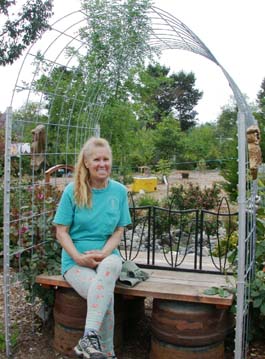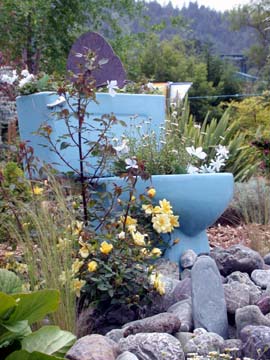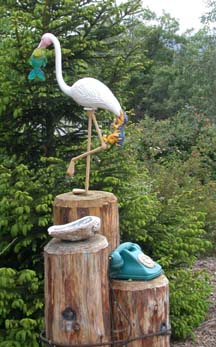|
Stage frightby AMY STEWART LAST WINTER I SPOKE TO A LOCAL GARDEN CLUB. I was supposed to read from my new book, but mostly I tried to solicit advice from the audience. I'd only been in town for a year and I still hadn't adjusted my gardening habits to account for the differences between Eureka and my old hometown, Santa Cruz. It was cooler here and damper. There were a few insects I hadn't done battle with before. "When do you plant tomatoes?" I asked the group. "What do you do about blackspot? How do you get rid of those tent caterpillars?" Gardeners are always eager to share their information. They helped me out as much as they could. I mentioned that I'd brought dozens of plants with me from my old garden, making three trips from Santa Cruz in my Corolla. "So what does your new garden look like?" someone asked. I beamed with the pride of a new parent. "Oh, it's really come along in the first year," I said. "I brought daisies and coreopsis and Mexican sage and catmint and cosmos seeds and -- well, it's really something in the summer. You should come see it." Now, most gardeners suffer from a strange neurosis about their gardens. I certainly do. I am quick to brag, quick to make sweeping proclamations about the season's success and quick to invite my friends over to see it in its glory. Then someone takes me up on that invitation and panic sets in. Out come the excuses: The garden is not at its best; the snails have been especially bad this year; we're still due for another cold snap; the weeds got out of control and I'm too busy to cut them down and too broke to truck in another load of mulch to smother them. None of these excuses worked when my friend from the garden club called to take me up on the invitation I issued at the meeting last winter. "Nothing's in bloom," I said feebly. "I've been out of town. It's a mess." "We're not coming until mid-June," my friend said firmly. "It'll look great by then." I sighed and agreed. "You're right," I said. "June's a long way off. It'll be fine." I hung up and stood looking out at the backyard, where the bindweed and the crabgrass had long ago declared victory. Why would anyone want to come see this garden? It was then that I realized that the Humboldt Botanical Gardens Foundation's annual tour was coming up. Ten gardeners will be opening their gardens to more than a select group of friends: They will invite in the entire community. How does anybody get their garden ready for an event like that? Do they hire a staff? Do they stay out all night, looking for snails? And do they give in to temptation and run down to the nursery the week before the tour and buy big, blooming plants to fill in the empty spots? I wanted to know, so I went to visit June MacDonald in Blue Lake. [in photo below left] This will be her first year on the tour. I'd heard she had a large spread, nearly two acres. It takes guts to plant a garden that big. A garden that size is more than a collection of plants around a house; a two-acre garden makes a statement.
June greeted me in the driveway and led me into the garden. "I built all this up with wood chips," she said, pointing to the raised beds that line the paths. "People always ask me how I can get anything to grow in all this wood chip mulch, but look. The plants love it." Sure enough, I looked around and saw an eclectic collection of evergreens and blooming perennials, shrubs and small trees, vines and annuals, all thriving in a dense layer of wood chips. And not a weed in sight. "That's the best part," she said. "I don't spend any time pulling weeds. Good thing, too. I do everything myself, and I've got half a mile of hedges to trim! And a whole new section of garden I haven't started yet!"
She takes cuttings and gathers seeds, shops the sale tables at the nursery and is always on hand when a friend is moving to take home any plants that would otherwise be left behind. But thanks to June's strong sense of design, the garden doesn't look haphazard. Paths meander toward focal points, such as benches and birdbaths. A dry creek provides a home for arid plants; a pond in an old metal tub houses water-loving plants. Vegetables grow in long beds sheltered by rows of hedges: garden rooms in the tradition of English kitchen gardens. It was stunning, really lovely, and I told her so.
A look came across her face, that look of worry I know so well. "Do you think so?" she asked. "Do you think it's ready? Really?" Perhaps this is the universal truth about gardens: They're never ready. They're never complete. To go on a garden tour is to see a garden at one moment in time. It is no longer the garden it was, but it is not yet the garden it will become. That's true of June MacDonald's enormous garden of adopted plants and junkyard salvage, and it's true of mine as well.
See June MacDonald's garden and nine others on the Humboldt Botanical Gardens Foundation tour on June 23, 2002. Tickets are $12 in advance and may be purchased at local garden shops and nurseries and through HBGF directly. HBGF hopes to break ground this summer at the garden site at College of the Redwoods. More than $2.5 million has been raised to build the garden and about $2 million more is needed. Call 442-5139 to buy tickets or get more information. E-mail garden news, announcements, insights and inquiries to Amy Stewart. Comments? E-mail the Journal: [email protected] IN THE NEWS | COVER STORY | SUMMER FESTIVALS GUIDE | CALENDAR © Copyright 2002, North Coast Journal, Inc. |


 I arrived in Blue Lake on an unusually warm, sunny afternoon. June's driveway is hard to miss: It is lined with 18-wheeler tire rims, all painted blue, filled with soil and planted with blooming annuals. In fact, as the garden tour brochure promised, junkyard treasures are the theme of June's garden. Old wheelbarrows, wrought iron headboards, and metal containers of all kinds are arranged around her garden and painted the same shade of deep blue. A blue bathtub sits in one corner, a blue sink in another, and I'm pretty sure I saw a blue toilet in there somewhere [photo below right]. All had been overcome by sweet pea vines, petunias, strawberries and daisies. The whole place had an air of planned chaos, and also, I thought guiltily, of someone who invests far more time and thought into her garden than I ever have.
I arrived in Blue Lake on an unusually warm, sunny afternoon. June's driveway is hard to miss: It is lined with 18-wheeler tire rims, all painted blue, filled with soil and planted with blooming annuals. In fact, as the garden tour brochure promised, junkyard treasures are the theme of June's garden. Old wheelbarrows, wrought iron headboards, and metal containers of all kinds are arranged around her garden and painted the same shade of deep blue. A blue bathtub sits in one corner, a blue sink in another, and I'm pretty sure I saw a blue toilet in there somewhere [photo below right]. All had been overcome by sweet pea vines, petunias, strawberries and daisies. The whole place had an air of planned chaos, and also, I thought guiltily, of someone who invests far more time and thought into her garden than I ever have. June scavenges plants as well as garden ornaments. As we walked, she pointed to a climbing rose. "My daughter had that in a pot for years, and it wasn't doing anything for her, so finally she said, `Mom, you take it.' Most of my plants come to me like that."
June scavenges plants as well as garden ornaments. As we walked, she pointed to a climbing rose. "My daughter had that in a pot for years, and it wasn't doing anything for her, so finally she said, `Mom, you take it.' Most of my plants come to me like that." "People on the tour are going to love this," I said. "It's just beautiful."
"People on the tour are going to love this," I said. "It's just beautiful."